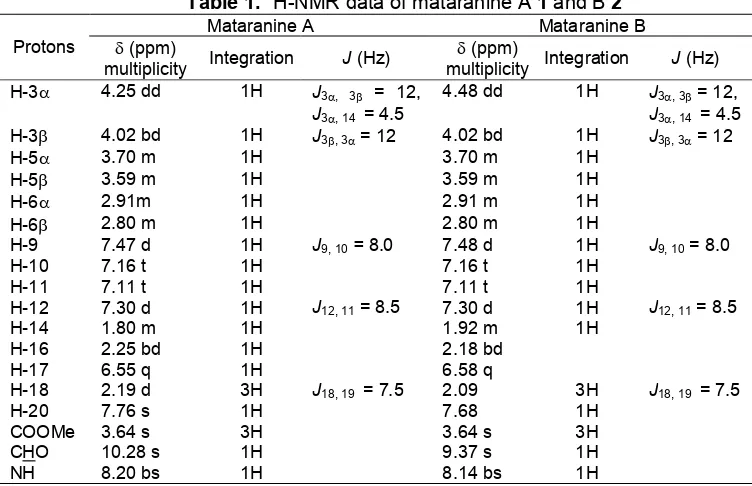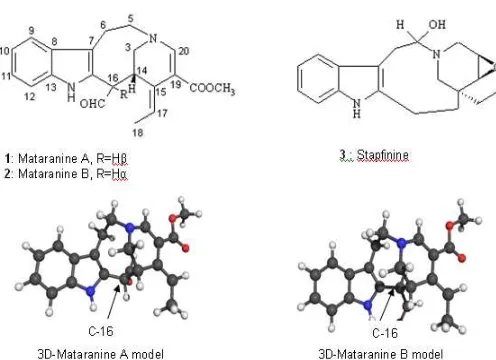Indo. J. Chem., 2009, 9 (3), 505 - 508
Surya Hadi
505
* Corresponding author. Tel/Fax : +62-370-634110 Email address : sur_hadi@telkom.net
MATARANINE A AND B: A NEW DIASTOMERIC INDOLE ALKALOID FROM
Alstonia
scholaris
R.Br. OF LOMBOK ISLAND
Surya Hadi
Study Program of Chemistry, University of Mataram, Jl. Majapahit 62, Mataram-NTB 83125
Received December, 20, 2008; Accepted September 16, 2009
ABSTRACT
Alstonia scholaris R. Br., (Apocynaceae) is widely distributed in Indonesia and in Lombok Island, the plant locally known as “lolon nita” has been used to treat malaria. To locate potential bioactive compounds, acid-base extraction was carried out. From the base fraction, two new indole alkaloids with diastomeric structure, named Mataranine A and B, were isolated. The structures of the two alkaloids were elucidated on the basis of UV, NMR and mass spectral data.
Keywords:alkaloids, Alstonia scholaris, Lombok, mataranine
INTRODUCTION
The plant Alstonia scholaris is the tallest tree belonging to the family Apocynaceae and grows to a height of 20-25 m and a diameter of 40-80 cm. This tree, the most widely distributed species of the genus, occurs in the region from India to South China and the south Ryukyu islands through Indonesia, the Philippines and Solomon islands. Alstonia scholaris, known as “nita” in Lombok, is common in areas up to 900 m above sea level. Initial investigations of the constituents of Alstonia species were stimulated by knowledge that extracts of the plant were commonly used as a cure for malaria. Until the second review ofAlstonia alkaloids in 1970 [1], there had been no reports suggesting that Alstonia extracts or its pure isolated alkaloids were effective antimalarial agents. In 1999 the Keawpradub group [2], reported that the methanol extract of the root bark ofA. macrophylla, collected from Thailand, exhibited antiplasmodial activity. They observed that pronounced antiplasmodial activity occurred mainly among the bisindole alkaloids.
In Lombok, the concentrated aqueous extracts of the leaves or bark of young trees (3-5 years) have been used to treat malaria. A particular point of interest is that young leaves from young trees are used specifically. Antimalarial testing by Yamauchi and Abe [3] with Plasmodium falciparum, revealed that the alkaloids obtained from leaves of A. scholaris from Lombok were active, but no specific mention was made of the age of the trees from which the alkaloids were isolated. Therefore, there was good reason for a thorough investigation of the young trees of this species. Moreover, during the course of this project, it was found that the alkaloids are distributed through the entire young plant including leaves, bark, roots, and fruit. In
this study, the investigation of antimalarial agents is focused only on the leaves from which the two new diastomeric indole alkaloids reported were isolated.
EXPERIMENTAL SECTION
Material
Alstonia scholaris R. Br. was collected from Narmada, West Lombok with permission of the local government and in collaboration with the University of Mataram, Lombok, Indonesia. The plant collection and identification were carried out by botanists from the University of Mataram and the Research and Development Centre for Biology, Bogor, Indonesia. A voucher specimen (voucher KWL01) was deposited at the Laboratory of Biology, the University of Mataram.
Instruments
Indo. J. Chem., 2009, 9 (3), 505 - 508
Surya Hadi
506
use and their ratios are v/v. The 3D-structure modelling was performed by minimizing conformation energies on Spartan Version 4.1.
Procedure
Finely-powdered, air-dried young leaves (1.5 kg) from young trees (up to 2.0 m high) were extracted with cold MeOH (3 x 3.0 litres) with occasional swirling. Methanol extraction was discontinued when the residual plant material gave a negative result for Mayer's test for alkaloids. After filtration, the solvent was removed under reduced pressure at 40 °C yielding a dark-blue MeOH extract (218.7 g). The crude alkaloid mixture was then separated from neutral and acidic material, and water solubles, by initial extraction with aqueous acetic acid (300 mL; 5%, v/v) followed by dichloromethane (DCM) extraction (3 x 500 mL) of the aqueous acid extract, which was then basified with aqueous sodium carbonate solution (10%) to pH 10, and then extracted with dichloromethane (3 x 200 mL). The solvent was evaporated under reduced pressure to give a crude alkaloid residue (753.6 mg) which was chromatographed (PTLC) on silica gel (DCM:MeOH:conc. NH4OH/17:2.5:0.5) with multiple development resulting in the isolation of Mataranine A and B as a mixture (28.3 mg; major).
Mataranine A 1
A light yellow oil mixed with mataranine B (approximate ratio A:B from 1H-NMR 1:1); UV
maxnm (CHCl3), 283, 291; 12), 118.3 9), 120.0 10), 122.4 11), 126.5 13), 127.9 8), 136.4 19), 143.7 17), 143.8 (C-2), 146.2 (C-15), 147.7 (C-20), 153.1 (COOCH3), 196.1 51.3 (C-3), 51.3 (C-5), 108.7 (C-7), 111.3 (C-12), 118.3 (C-9), 120.0 (C-10), 122.4 (C-11), 126.5 (C-13), 128.9 (C-8), 136.4 (C-19), 140.0 (C-2), 143.7 (C-17), 147.7 (C-20), 152.0 (C-15), 168.4 (COOCH3), 190.6 (CHO).RESULT AND DISCUSSION
These new alkaloids, that the author has called mataranine A1 and mataranine B2, were obtained as a light yellow oil in the form of a 1:1 diastereomeric mixture, which could not be separated fully by PTLC. However, separating the top and bottom portions of the band on the TLC plate changed the ratio of the resultant two compounds (after extraction from the silica gel), which assisted in differentiating their spectra and hence elucidating their structures. The mixture of1 and2showed absorbance maxima at 283 and 291 nm in the UV spectrum consistent with an indole chromophore being present. The presence of the aldehyde and methyl ester (COOMe) groups was suggested by the LREIMS spectrum with peaks at m/z 321 (M+-29), and 291 (M+-59) respectively. LRCIMS gave an ion of m/z 351 [MH]+ and the LREIMS spectrum showed the [M]+ ion at m/z 350. The empirical formula was established by HRCIMS as C21H21N2O3 (measured 351.1711, calc. 351.1709, for MH+).
To elucidate the structure of the mataranines,1 H-and13C-NMR spectra were collected and proton-proton connectivity was deduced from a gCOSY spectrum. The proton-carbon connectivity was assigned by recording gHSQC and gHMBC experiments and these experiments were complemented by DEPT spectra. These results are summarised in Tables 1 and 2.
Indo. J. Chem., 2009, 9 (3), 505 - 508
Surya Hadi
507
Table 1.1H-NMR data of mataranine A1and B2
Mataranine A Mataranine B Protons (ppm)
multiplicity Integration J(Hz) (ppm)
multiplicity Integration J(Hz) H-3 4.25 dd 1H J3, 3 = 12,
J3, 14 = 4.5
4.48 dd 1H J3, 3= 12, J3, 14 = 4.5
H-3 4.02 bd 1H J3, 3= 12 4.02 bd 1H J3, 3= 12
H-5 3.70 m 1H 3.70 m 1H
H-5 3.59 m 1H 3.59 m 1H
H-6 2.91m 1H 2.91 m 1H
H-6 2.80 m 1H 2.80 m 1H
H-9 7.47 d 1H J9, 10=8.0 7.48 d 1H J9, 10= 8.0
H-10 7.16 t 1H 7.16 t 1H
H-11 7.11 t 1H 7.11 t 1H
H-12 7.30 d 1H J12, 11= 8.5 7.30 d 1H J12, 11= 8.5
H-14 1.80 m 1H 1.92 m 1H
H-16 2.25 bd 1H 2.18 bd
H-17 6.55 q 1H 6.58 q
H-18 2.19 d 3H J18, 19 = 7.5 2.09 3H J18, 19 = 7.5
H-20 7.76 s 1H 7.68 1H
COOMe 3.64 s 3H 3.64 s 3H
CHO 10.28 s 1H 9.37 s 1H
NH 8.20 bs 1H 8.14 bs 1H
Table 2.13C-NMR Data of Mataranine A1and B2
Mataranine A Mataranine B Carbon No.
Chemical shift Carbon type (DEPT) Chemical shift Carbon type (DEPT)
2 143.8 -C- 140.03
-C-3 51.3 CH2 51.3 CH2
5 51.3 CH2 51.3 CH2
6 22.3 CH2 22.3 CH2
7 108.7 -C- 108.7
-C-8 127.9 -C- 128.9
-C-9 118.3 CH 118.3 CH
10 120.0 CH 120.0 CH
11 122.4 CH 122.4 CH
12 111.3 CH 111.3 CH
13 126.5 -C- 126.5
-C-14 30.5 CH 28.6 CH
15 146.2 -C- 152.0
-C-16 47.7 CH 49.5 CH
17 143.7 CH 143.7 CH
18 15.3 CH3 13.5 CH3
19 136.4 -C- 136.4
-C-20 147.7 CH 147.7
-C-COOMe 153.1 168.4
COOMe 50.9 CH3 50.9 CH3
CHO 196.1 CH 190.6 CH
program) indicated that with the C-16 proton in thealpha position, the aldehyde proton is closer to the lone pair of electrons on N-1, than is the case with the epimer at C-16. This is consistent with a downfield shift of the signal ascribed to aldehyde proton (10.28 vs 9.37) in the former case. The position of the aldehyde functionality (CHO) was determined by the gHMBC spectrum. In mataranine A, the CHO signal at 10.28 showed cross peaks to signals at143.8 (C-2) and30.5 (C-14).
Indo. J. Chem., 2009, 9 (3), 505 - 508
Surya Hadi
508
Figure 1. Computer-Derived 3D-Mataranine Models
triplets centred around7.16 and 7.11 were assigned to H-10 and H-11 respectively. A broadened singlet was observed at8.20, consistent with an indolic NH proton. Another singlet, at 7.76, was assigned to H-20 with cross peaks in the gHMBC spectrum to 136.4 (C-19), 50.9 (OMe), 47.7 (C-16), and 28.6 (C-14), which is consistent with the proposed structure.
The methyl ester appeared as a three-proton singlet at 3.64. The observed broad doublet signal at
2.25 was ascribed to H-16. From the gCOSY spectrum, H-16 (2.25) was coupled to a multiplet at 1.80 (H-14) that also coupled to two broadened downfield doublets at 4.25 (H-3) and 4.02 (H-3), suggesting the presence of a (–CH-CH-CH2-N-) moiety. The ethylidene group was identified by the observation of a one-proton quartet at6.55 (H-17) coupled to a three-proton doublet at 2.19 (H-18, J18, 17 = 7.5 Hz). The position of the ethylidene group was confirmed by the gHMBC spectrum, which showed a weak cross peak from 6.55 (H-17) to 196.1 (aldehyde) and 30.5 (C-14). The (Z) stereochemistry about the double bond was indicated by an NOE observed between H-17 (6.55) and the aldehyde proton. Four distinct multiplets centred around
3.70, 3.59, 2.91, and 2.80 were assigned to the H-5, H-5, H-6, and H-6protons respectively.
The mataranines are representative of a new indole alkaloid skeleton, which has C-16 linked to C-14 to form an eight membered ring. They may be derived from a cleavamine-velbanamine alkaloid type (e.g. stapfinine3), which have been isolated from three main species belonging to the family Apocynaceae:
Tabernaemontana eglandulose [4], Ervatamia
coronaria[5], andRhazya stricta[6].
CONCLUSION
A new diastomeric indole alkaloid, named Mataranine A and B, were successfully isolated in young leaves of Alstonia scholaris collected from Lombok Island. All measured spectral data are consistent with the proposed chemical structure of mataranine A and B.
ACKNOWLEDGEMENT
I would like to give my sincere thanks to my supervisor Prof. John B. Bremner for this continuous guidance and support during the course of this research. Thanks are extended to AusAid for funding this study.
REFERENCES
1. Saxton, J.E., 1970, Alkaloids, 12, 207-244.
2. Keawpradub, N., Kirby, G.C., Steele, J.C.P., and Houghton, P.J., 1999, Planta Med., 65, 690-694. 3. Yamauchi, T. and Abe, F., 1998, Int. Congr. Ser.,
1157, 51-58.
4. Van Beek, T.A.; Verpoorte, R., and Svendsen, A.B., 1984, Tetrahedron Lett., 25, 2057-2060. 5. Atta-Ur-Rahmán, and Muzaffar, A., Phytochem.,
24, 2473-2474.

